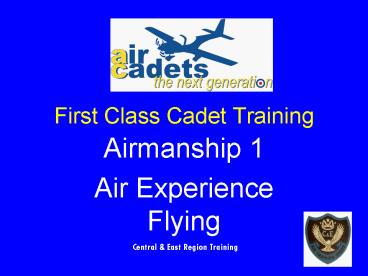First Class Cadet Training - PowerPoint PPT Presentation
1 / 56
Title:
First Class Cadet Training
Description:
Understand the types of AEF in the ATC. Introduce the ATC Basic ... Cockpit Layout. Flight Instruments - Altimeter. Attitude Indicator (or Artificial Horizon) ... – PowerPoint PPT presentation
Number of Views:347
Avg rating:3.0/5.0
Title: First Class Cadet Training
1
First Class Cadet Training
- Airmanship 1
- Air Experience Flying
Central East Region Training
2
Air Experience Flying
3
Objectives
- Understand the types of AEF in the ATC
- Introduce the ATC Basic Trainer The Tutor
- Have a basic understanding of Flight Controls
- Understand Safety in the Air
- Understand Safety on the Ground
- Review the Tutor Passenger Brief Video
4
Flying in the ATC
- Air Experience flights Grob Tutor 115E
- Operational Aircraft on a opportunity basis
- Civil Flights on an opportunity basis
- Must be 13 years 3 months
- Have at least had safety brief OR 1st Class
cadet
5
Opportunity Flights in Operational Aircraft
Chinook
6
Opportunity Flights in Operational Aircraft
Tristar
7
Opportunity Flights in Operational Aircraft
Hercules
8
Your Local Air Experience Flight
9
Grob Tutor 115E
Grob Tutor 115E
10
Single Engined, Low Wing Monoplane with Fixed
Undercarriage
11
(No Transcript)
12
(No Transcript)
13
(No Transcript)
14
(No Transcript)
15
Grob Tutor 115E
Wingspan 10.0m Length 7.6m Height
2.8m Max Weight 990Kg Engine 180hp Max
Speed 185Kts
Side-by-side 2 seat Carbon Fibre construction
16
Cockpit Layout
17
Flight Instruments - Altimeter
18
Attitude Indicator (or Artificial Horizon)
19
Airspeed Indicator
20
Vertical Speed Indicator
21
FLIGHT CONTROLS
22
Control Surfaces
23
The Axes of an Aircraft
24
- Elevator
25
(No Transcript)
26
Elevator moves down
27
And continues to do so until the control column
is placed in a neutral position
Airspeed will increase
28
- Control column back
- Elevator moves up
- Nose pitches up
- Speed will decrease
29
- Ailerons
30
(No Transcript)
31
Left aileron down
Right aileron up
32
And continues to do so until the control column
is placed in the neutral position
Aircraft rolls right
33
- Control column left
- Left aileron up
- Right aileron down
- Aircraft rolls left
34
- Rudder
35
(No Transcript)
36
Rudder moves right
37
Aircraft yaws right
38
SAFETY ON THE GROUND
39
When on the Ground
- Never approach an aircraft unless told to so
- Never walk towards the propeller. Always approach
from an angle that can be seen - Remove any hats in the aircraft dispersal area
Look Listen
40
(No Transcript)
41
Parachute Fitted
42
Seat Harness
43
Rip Cord Extended
ONLY PULL THIS CORD IN AN EMERGENCY BALE OUT!
AND WHEN YOU HAVE FALLEN CLEAR OF THE AIRCRAFT
44
When on the Ground
- If a Jet beware of both the intake and the
exhaust areas - Keep hands away from your parachute D ring
- Listen to the Ground crews or Staff Cadets
45
Ready to go!
46
SAFETY IN THE AIR
47
While in the Air
- Talk to the pilot ask questions
- Ask to see the effects of controls
- Ask about the instruments
- Only touch the controls when told to do so
48
While in the Air
- Keep hands feet away from the controls if you
are not flying the aircraft - Listen to any commands, if not sure ask to repeat
- Ensure that you have no loose articles in your
pocket
49
Summary
- Ask Questions
- Ask to take control
- Do not touch unless told to do so
- Think Safe
- Look Listen
50
ENJOY YOUR FLIGHT
51
Objectives
- Understand the types of AEF in the ATC
- Introduce the ATC Basic Trainer The Tutor
- Have a basic understanding of Flight Controls
- Understand Safety in the Air
- Understand Safety on the Ground
- Review the Tutor Passenger Brief Video
52
Any Questions?
53
Questions
- What does AEF stand for?
- Name the aircraft we use for AEF?
- What is the number of your local AEF?
- What happens when you move the control column to
the right? - From which direction should you approach the
Tutor?
54
Questions
- Which control can you touch first?
- What is an ASI?
- What is an Artificial Horizon?
- What is this?
55
(No Transcript)
56
Acknowledgements
- Flt Lt D Martin RAFVR(T) WSO Warwickshire
Birmingham Wing (on whose slides this
presentation is based) - Photos from the MOD website
- ACCGS RAF Syerston































